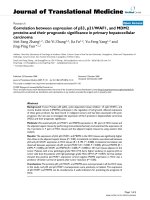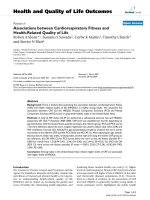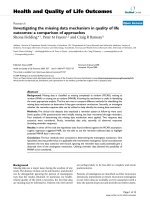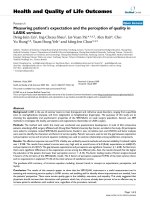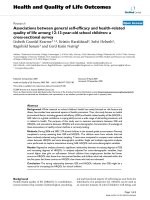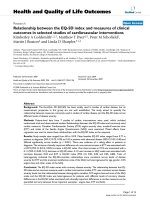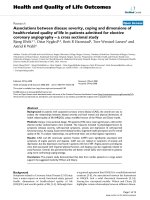báo cáo hóa học: " Associations between Cardiorespiratory Fitness and Health-Related Quality of Life" pdf
Bạn đang xem bản rút gọn của tài liệu. Xem và tải ngay bản đầy đủ của tài liệu tại đây (337.75 KB, 5 trang )
BioMed Central
Page 1 of 5
(page number not for citation purposes)
Health and Quality of Life Outcomes
Open Access
Research
Associations between Cardiorespiratory Fitness and
Health-Related Quality of Life
Robert A Sloan*
1
, Susumu S Sawada
2
, Corby K Martin
3
, Timothy Church
3
and Steven N Blair
4
Address:
1
Health Promotion Center, United States Naval Hospital Yokosuka, Kanagawa, Japan,
2
Health Promotion Center, Tokyo Gas Co., Ltd,
Tokyo, Japan,
3
Pennington Biomedical Research Center, Baton Rouge, Louisiana, USA and
4
University of South Carolina, Columbia, South
Carolina, USA
Email: Robert A Sloan* - ; Susumu S Sawada - ; Corby K Martin - ;
Timothy Church - ; Steven N Blair -
* Corresponding author
Abstract
Background: There is limited data examining the association between cardiorespiratory fitness
(CRF) and health related quality of life (HRQOL) in healthy young adults. We examined the
association between CRF and the HRQOL Physical Component Summary (PCS) and Mental
Component Summary (MCS) scores in apparently healthy males in the United States Navy.
Methods: A total of 709 males (18–49 yr) performed a submaximal exercise test and HRQOL
assessment (SF-12v2™) between 2004–2006. CRF level was classified into fourths depending on
age distribution with the lowest fitness quartile serving as the referent group. PCS and MCS scores
≥ 50 were defined as above the norm. Logistic regression was used to obtain odds ratios (OR) and
95% confidence intervals (CI). ResultsThe age-standardized prevalence of above the norm scores
was lowest in the referent CRF quartile, PCS 56.6% and MCS 45.1%. After adjusting for age, systolic
blood pressure, body mass index, smoking habit, alcohol habit and using the lowest CRF group as
the reference, the OR (95% CI) for PCS scores above the norm across the fitness quartiles (P <
0.003 for trend) were 1.51(0.94–2.41), 2.24(1.29–3.90), and 2.44 (1.30–4.57); For MCS the OR
(95% CI) were across the fitness quartiles (P trend < 0.001) 2.03(1.27–3.24), 4.53(2.60–7.90),
3.59(1.95–6.60).
Conclusion: Among males in the United States Navy relative higher levels of CRF are associated
with higher levels of HRQOL.
Introduction
The Centers for Disease Control and Prevention and the
Agency for Healthcare Research and Quality consider the
surveillance of mental and physical health to be impera-
tive in understanding health-related quality of life
(HRQOL) and its impact on increasing the quality and
years of healthy life, eliminating health disparities, and
predicting future medical health care costs [1,2]. Higher
levels of cardiorespiratory fitness (CRF) have been shown
to be associated with higher levels of HRQOL in the older
and chronically diseased populations [3,4]. However,
there is a dearth of evidence on the association of CRF
level and HRQOL in apparently healthy young adults. A
recent systematic review highlighted the public health
Published: 28 May 2009
Health and Quality of Life Outcomes 2009, 7:47 doi:10.1186/1477-7525-7-47
Received: 11 March 2009
Accepted: 28 May 2009
This article is available from: />© 2009 Sloan et al; licensee BioMed Central Ltd.
This is an Open Access article distributed under the terms of the Creative Commons Attribution License ( />),
which permits unrestricted use, distribution, and reproduction in any medium, provided the original work is properly cited.
Health and Quality of Life Outcomes 2009, 7:47 />Page 2 of 5
(page number not for citation purposes)
importance of better understanding the relation between
physical activity and HRQOL in the general adult popula-
tion [5]. Specifically, the authors noted that cross-sec-
tional studies demonstrated positive associations between
physical activity and HRQOL. The review presented mini-
mal evidence for the relationship of objectively measured
CRF and the mental and physical health components of
HRQOL. It is well accepted that the primary marker for
habitual physical activity is objectively measured CRF [6].
Therefore, this observational study sought to evaluate the
association between CRF level and the physical and men-
tal components of HRQOL in apparently healthy young
males.
Methods
Data Source
The data were obtained from the Naval Hospital Yoko-
suka, Japan, Health Promotion Center health fitness
assessment (HFA) database. A component of the HFA was
the Short Form 12 version 2 (SF-12v2™) questionnaire
[7]. Trained U.S. Navy medical personnel record the data
during each initial HFA. The HFA data for this observa-
tional study was approved as exempt research by the Navy
Medical Research Center, San Diego Institutional Review
Board.
Participants
For these analysis, data were examined from the review of
1127 HFA records of male United States Navy service
members who were self-referred or referred by their pri-
mary care manager for health related lifestyle manage-
ment counseling during 2004–2006. Participants
included in the study were 18–49 years old, had been in
the Navy for at least 6 months, graduated high school, and
were considered apparently healthy documented by med-
ical record review. Exclusion criteria included any partici-
pant with a history of a chronic condition or disease,
psychotropic medication, cholesterol medication, blood
pressure medication, an inability to reach 85% of maxi-
mal heart rate during the submaximal graded exercise test,
or were missing any data required for the analysis. Any
participant who reported smoking on the morning of the
HFA was excluded from the database to avoid inaccurate
prediction of metabolic equivalent (MET) capacity from
the treadmill test. After review of the database 709 (62.9%
of the original sample), apparently healthy participants
were eligible for inclusion. Ethnicity and education level
beyond high school were not recorded. All participants
had a review of their medical record when they arrived for
the HFA, which is primarily used to note any relative or
absolute contraindications prior to exercise testing [8].
The SF-12v2™ was completed along with a generic self-
report health risk appraisal that included tobacco and
alcohol use questions. All medications were verified and
documented prior to resting blood pressure and cardiores-
piratory fitness testing. Resting heart rate and ausculatory
blood pressure were completed per the JNC 7 guidelines
[9].
Assessment and definition of health-related quality of life.
HRQOL is defined as the perception of overall satisfaction
with life and involves the measurement of functional sta-
tus in the domains of physical, cognitive, emotional, and
social health, and is a fundamental assessment in under-
standing the health status of a population [10]. The SF-
12v2™ is a generic health status instrument that assesses
HRQOL by asking twelve Likert scale questions that meas-
ure eight domains: physical function, role-physical, bod-
ily pain, general health, vitality, social functioning, role-
emotional, and mental health [7]. These eight domains
are summarized into physical (PCS) and mental (MCS)
component summary scales via established norm based
scoring (NBS) algorithms [11]. Once the scores are trans-
formed, the general population has a mean of 50 and a
standard deviation of 10. Therefore when compared to the
general population, HRQOL is considered to be below the
norm if PCS or MCS scores are calculated to be below 50.
Assessment and definition of cardiorespiratory fitness.
Each submaximal CRF test began within 30 minutes post
completion of the SF-12v2™ questionnaire. A modified
Balke protocol started at 88 m·mm
-1
(3.3 mph) and began
with a grade of 0% and after every 3 minutes the grade was
increased by 3% until the participant reached 85% of their
age predicted heart rate max. Maximal MET level was esti-
mated by using the method of extrapolation to the age
predicted maximal heart rate [8]. ACSM guidelines for
submaximal exercise testing were followed throughout
the course of each test and all tests were administered by
ACSM certified personnel [8]. We categorized participants
into quartiles depending on age-specific (18–24, 25–29,
30–34, 35–39, 40–45, and 45–49) distributions of esti-
mated maximal MET level.
Data Analysis
Estimated maximal MET capacity levels were divided into
quartiles with the lowest quartile serving as the referent
group. Descriptive statistics were examined across fitness
quartiles. Logistic regression was used to calculate odds
ratios (OR) and 95% confidence intervals (CI) with the
lowest CRF quartile as the reference category. OR were
adjusted for age, body mass index, systolic blood pressure,
current smoking (yes or no), and current alcohol intake (<
14 or ≥ 14 drinks per week). The Statistical Package for
Social Science (version 12.0) was used for statistical anal-
ysis (SPSS, Inc., Chicago, Illinois, USA). All probability
values of P < 0.05 were considered statistically significant.
Results
Table 1 depicts baseline characteristics of the subjects (N =
709) according to CRF. Men in the referent quartile (9.7 ± 1.1
METS) had mean PCS and MCS scores below 50. Table 2
Health and Quality of Life Outcomes 2009, 7:47 />Page 3 of 5
(page number not for citation purposes)
depicts the OR and CI for above the norm PCS and MCS
scores by age-specific CRF levels, with the lowest CRF level as
the referent. We observed significant positive trends across
CRF categories for the prevalence and OR of PCS and MCS
scores above the median. After multivariate adjustment for
several potential confounding variables, low CRF was associ-
ated with low PCS and MCS scores. Pearson correlation coef-
ficients between MCS vs. MET and PCS vs. MET were r =
0.078 (p = 0.037) and r = 0.269 (p < 0.001) respectively.
Discussion
This observational study investigated the association
between CRF and HRQOL in young, apparently healthy
men in the U.S. Navy. Our results suggest that there is a
positive relationship between the level of CRF and the
mental and physical health components of HRQOL. To
the best of our knowledge, this is the first study to evaluate
the associations between objectively measured CRF and
HRQOL in apparently healthy young men.
Brown et al. conducted a large (N = 175,850) cross-sec-
tional study on self-reported physical activity and HRQOL
using the 2001 Behavioral Risk Factor Surveillance System
(BRFSS) database [12]. A graded dose response relation-
ship was established for physical activity and HRQOL that
supports the current physical activity recommendations
by the American College of Sports Medicine and the
American Heart Association [13]. Puetz reviewed the epi-
demiological evidence for the dose response relationship
between physical activity and vitality [14]. Vitality is one
component for HRQOL that is used in the determination
of MCS and PCS scoring. His review demonstrated consid-
erable evidence that the greatest risk for low vitality is
associated with sedentary lifestyle. Even though subjective
measures of physical activity were used, the Brown et al.
study and Puetz's review provide strong evidence for the
relationship of physical activity and HRQOL.
Our study is one of only two studies that have demon-
strated a relationship between objectively measured CRF
level and HRQOL [5]. Galper et al. [15] reported a similar
positive relation between CRF and mental health by meas-
uring emotional well-being in 5230 men from the Aero-
bics Center Longitudinal Study. Although the authors
used a different tool to quantify HRQOL, emotional well-
being is considered to be a component of HRQOL.
Table 2: Odds ratios above the norm for MCS and PCS according to cardiorespiratory fitness levels
Cardiorespiratory fitness levels, quartiles
Q
1
(Referent) Q
2
Q
3
Q
4
(High) P for trend
n 175 178 180 176
PCS
Prevalence of PCS Scores ≥ 50 56.6 69.1 78.3 81.3
Age-adjusted OR (95% CI) 1.00 1.72 (1.11–2.67) 2.81 (1.76–4.48) 3.35 (2.06–5.44) < 0.001
Multivariate OR* (95% CI) 1.00 1.51 (0.94–2.41) 2.24 (1.29–3.90) 2.44 (1.30–4.57) 0.003
MCS
Prevalence of MCS Scores ≥ 50 45.1 61.8 77.2 73.3
Age-adjusted OR (95% CI) 1.00 2.06 (1.33–3.19) 4.45 (2.77–7.13) 3.62 (2.28–5.75) < 0.001
Multivariate OR* (95% CI) 1.00 2.03 (1.27–3.24) 4.53 (2.60–7.90) 3.59 (1.95–6.60) 0.001
OR, odds ratio; CI, confidence interval.
*Adjusted for age, BMI, systolic blood pressure, alcohol, habit, smoking habit.
Table 1: Baseline characteristics of men according to cardiorespiratory fitness levels
Cardiorespiratory fitness levels, quartiles
Characteristics All men Q
1
(Referent) Q
2
Q
3
Q
4
(High)
n 709 175 178 180 176
Age (years) 31.6 ± 7.4 31.7 ± 7.4 31.6 ± 7.4 31.7 ± 7.4 31.5 ± 7.4
PCS 52.3 ± 7.3 49.6 ± 7.8 52.0 ± 7.2 53.4 ± 7.0 54.3 ± 6.4
MCS 51.3 ± 8.3 48.0 ± 8.8 50.7 ± 8.0 53.5 ± 7.4 52.8 ± 7.7
Body mass index (kg·m
-2
) 28.7 ± 4.3 32.9 ± 3.8 29.6 ± 3.1 27.2 ± 2.9 25.3 ± 3.1
Systolic blood pressure (mmHg) 124.1 ± 11.6 126.1 ± 11.4 125.6 ± 12.6 122.2 ± 11.1 122.7 ± 10.8
Diastolic blood pressure (mmHg) 74.9 ± 10.3 76.7 ± 10.4 76.4 ± 10.3 73.6 ± 10.4 72.8 ± 9.6
Current smokers (%) 23.1 27.4 25.3 21.1 18.8
Current drinkers (%) 2.7 2.9 2.2 3.3 2.3
PCS, Physical Component Summary; MCS, Mental Component Summary.
*Data are means ± SD, unless otherwise specified.
Health and Quality of Life Outcomes 2009, 7:47 />Page 4 of 5
(page number not for citation purposes)
The present study had several strengths. First, CRF and
BMI were measured objectively. In comparison with self-
report methods of estimated physical activity, CRF is a
more objective measure [6]. It has also been found that
self-report methods of BMI are influenced by under
reporting for weight and over reporting for height [16].
Second, we used a well established, valid, and reliable
measure of HRQOL that utilized norm-based scoring
methodology. Norm based scoring allows for comparison
between other studies that evaluate PCS and MCS regard-
less of the SF version used and avoids the ceiling effect
sometimes seen in the eight SF-36 v2™ domains [5,11].
The third unique strength of this study was that the popu-
lation we observed was young and apparently healthy
U.S. Navy personnel.
The primary limitation of this study is that it was a cross-
sectional design from which we cannot determine a direct
cause and effect relationship. Generalizibility of this study
may be limited because it was conducted only with males
in the U.S. Navy. However, it should be noted, that base-
line HRQOL norms for the healthy U.S. population with
no chronic conditions, for PCS and MCS are 54.3 ± 6.2
and 52.3 ± 7.9, respectively [11]. These scores are only
slightly higher from our observed baseline PCS and MCS
mean scores of 52.3 ± 7.3 and 51.3 ± 8.3 respectively. Fur-
thermore, there appears to be some similarity between
our PCS and MCS baseline means and the U.S. Military
whereby the Millennium cohort study of (N = 77047)
unadjusted means for PCS and MCS norms were 53.4 and
52.8 respectively [17]. Although education level beyond
high school may be considered a confounding variable,
the Millennium cohort study indicted minimal to no sig-
nificant differences in education level for adjusted PCS
and MCS means [17]. The referral process (self or primary
care) may be considered a possible limitation influencing
motivation. The final limitation of our study is that sub-
maximal testing was used to estimate maximal MET level.
However, in its scientific statement on the Assessment of
Functional Capacity in Clinical and Research Settings, the
American Heart Association remarked that submaximal
testing is a valid method to assess CRF [18].
Conclusion
In conclusion the results of this study suggest that low
CRF is associated with lower HRQL in apparently healthy
young men. Future studies should focus on apparently
healthy women along with prospective and clinical
designs that demonstrate cause and effect. Also because of
the independent association found in our study and other
studies [4,12,14,15] between physical activity or CRF and
HRQOL, studies investigating the role of BMI level on
HRQOL should not exclude measures of physical activity
or CRF.
Competing interests
The authors declare that they have no competing interests.
Authors' contributions
RS designed and conducted the study and drafted the
manuscript. RS performed the data management, RA and
SS contributed to the statistical analysis. RS and SS partic-
ipated in the study design. RS, SS, CM, TC and SB contrib-
uted substantially to the manuscript. All authors read an
approved the final manuscript.
Acknowledgements
We thank Samuel Sloan for his editing support. Corby Martin is supported
by grant 1K23 DK068052 from the National Institutes of Health.
References
1. Centers for Disease Control and Prevention; National
Center for Chronic Disease Prevention and Health Promo-
tion Health-Related Quality of Life [ />publications_chrono.htm]
2. Fleishman JA, Cohen JW, Manning WG, Kosinski M: Using the SF-
12 health status measure to improve predictions of medical
expenditures. Med Care. 2006, 44(5 Suppl):I54-I63.
3. Lavie CJ, Milani RV: Disparate effects of improving aerobic
exercise capacity and quality of life after cardiac rehabilita-
tion in young and elderly coronary patients. J Cardiopulm Reha-
bil 2000, 40:235-40.
4. Rejeski WJ, Lang W, Neiberg RH, Van Dorsten B, Foster GD, Macie-
jewski ML, Rubin R, Williamson DF, Look AHEAD Research Group:
Correlates of health-related quality of life in overweight and
obese adults with type 2 diabetes. Obesity 2006, 14:870-83.
5. Bize R, Johnson JA, Plotnikoff RC: Physical activity level and
health-related quality of life in the general adult population:
a systematic review. Prev Med 2007, 45:401-15.
6. Blair SN, Cheng Y, Holder JS: Is physical activity or physical fit-
ness more important in defining health benefits? Med Sci
Sports Exerc 2001, 33:379-99.
7. Ware JE, Kosinski M, Keller SD: A 12-Item Short-Form Health
Survey: construction of scales and preliminary tests of relia-
bility and validity. Med Care 1996, 34:220-233.
8. American College of Sports Medicine: ACSM's Guidelines for Exercise
Testing and Prescription 7th edition. Baltimore (MD): Lippincott Wil-
liams & Wilkins; 2005.
9. Chobanian AV, Bakris GL, Black HR, Cushman WC, Green LA, Izzo
JL, Jones DW, Materson BJ, Oparil S, Wright JT, Roccella EJ:
National High Blood Pressure Education Program Coordi-
nating Committee Seventh Report of the Joint National
Committee on Prevention, Detection, Evaluation, and
Treatment of High Blood Pressure. Hypertension 2003,
42:1206-52.
10. Ware JE, Sherbourne CD: The MOS 36-item short-form health
survey (SF-36). I. Conceptual framework and item selection.
Med Care 1992, 30:473-83.
11. Ware JE, Kosinski M, Keller SD: SF-12: how to score the SF-12 physical
and mental health summary scales 3rd edition. Lincoln (RI): Quality
Metric Incorporated; 1998.
12. Brown DW, Brown Dr, Health GW, Balluz L, Giles WH, Ford ES,
Mohdad AH: Associations between physical activity dose
health-related quality of life.
Med Sci Sports Exerc 2004,
36:890-896.
13. Haskell WL, Lee IM, Pate RP, Powell KE, Blair SN, Franklin BA, Mac-
era CA, Heath GW, Thompson PD, Bauman A: Physical Activity
and Public Health: Updated recommendation for adults
from the American College of Sports Medicine and the
American Heart Association. Circulation 2007, 116:1081-93.
14. Puetz TW: Physical Activity and Feelings of Energy and
Fatigue:Epidemolgical Evidence. Sports Medicine 2006,
36:767-80.
Publish with BioMed Central and every
scientist can read your work free of charge
"BioMed Central will be the most significant development for
disseminating the results of biomedical research in our lifetime."
Sir Paul Nurse, Cancer Research UK
Your research papers will be:
available free of charge to the entire biomedical community
peer reviewed and published immediately upon acceptance
cited in PubMed and archived on PubMed Central
yours — you keep the copyright
Submit your manuscript here:
/>BioMedcentral
Health and Quality of Life Outcomes 2009, 7:47 />Page 5 of 5
(page number not for citation purposes)
15. Galper DI, Trivedi MH, Barlow CE, Dunn AL, Kampert JB: Inverse
association between physical inactivity and mental health in
men and women. Med Sci Sports Exerc 2006, 38:173-8.
16. Gorber SC, Tremblay M, Moher D, Gorber B: A comparison of
direct vs. self-report measures for assessing height, weight
and body mass index: a systematic review. Obes Rev 2007,
8:307-26.
17. Smith TC, Zamorski M, Smith B, Riddle JR, Leardmann CA, Wells TS,
Engel CC, Hoge CW, Adkins J, Blaze D, Millennium Cohort Study
Team: The physical and mental health of a large military
cohort: baseline functional health status of the Millennium
Cohort. BMC Public Health 2007, 26:340.
18. Arena R, Myers J, Williams MA, Gulati M, Kligfield P, Balady GJ, Collins
E, Fletcher G: Assessment of Functional Capacity in Clinical
and Research Settings: A Scientific Statement From the
American Heart Association Committee on Exercise, Reha-
bilitation, and Prevention of the Council on Clinical Cardiol-
ogy and the Council on Cardiovascular Nursing. Circulation
2007, 116:329-343.

